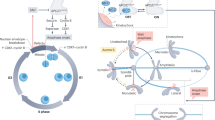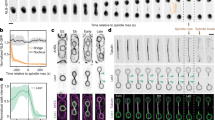Abstract
In the fission yeast Schizosaccharomyces pombe, cytokinesis is thought to be controlled by the daughter spindle-pole body (SPB) through a regulatory pathway named the septation initiation network (SIN). Here, we demonstrate that laser ablation of both, but not a single SPB, results in failure of cytokinesis. Ablation of only the daughter SPB often leads to activation of the SIN on the mother SPB and successful cytokinesis. Thus, either SPB can drive cytokinesis.
This is a preview of subscription content, access via your institution
Access options
Subscribe to this journal
Receive 12 print issues and online access
$209.00 per year
only $17.42 per issue
Buy this article
- Purchase on Springer Link
- Instant access to full article PDF
Prices may be subject to local taxes which are calculated during checkout

Similar content being viewed by others
References
Krapp, A., Gulli, M. P. & Simanis, V. Curr. Biol. 14, R722–R730 (2004).
Grallert, A., Krapp, A., Bagley, S., Simanis, V. & Hagan, I. M. Genes Dev. 18, 1007–1021 (2004).
Morrell, J. C. et al. Curr. Biol. 14, 579–584 (2004).
Sohrmann, M., Schmidt, S., Hagan, I. & Simanis, V. Genes Dev. 12, 84–94 (1998).
Khodjakov, A., La Terra, S. & Chang, F. Curr. Biol. 14, 1330–1340 (2004).
Khodjakov, A., Cole, R. W., Oakley, B. R. & Rieder, C. L. Curr. Biol. 10, 59–67 (2000).
Sparks, C. A., Morphew, M. & McCollum, D. J. Cell Biol. 146, 777–790 (1999).
Cerutti, L. & Simanis, V. J. Cell Sci. 112, 2313–2321 (1999).
Le Goff, X., Motegi, F., Salimova, E., Mabuchi, I. & Simanis, V. J. Cell Sci. 113, 4157–4163 (2000).
He, X., Patterson, T. E. & Sazer, S. Proc. Natl Acad. Sci. USA 94, 7965–7970 (1997).
Wu, J. Q. & Pollard, T. D. Science 310, 310–314 (2005).
Daga, R. R., Lahoz, A., Munoz, M. J., Moreno, S. & Jimenez, J. EMBO J. 24, 2436–2446 (2005).
Mishra, M. et al. J. Cell Sci. 117, 3897–3910 (2004).
Wu, J. Q., Kuhn, J. R., Kovar, D. R. & Pollard, T. D. Dev. Cell 5, 723–734 (2003).
Acknowledgements
This work was supported by National Institutes of Health grants GMS 59363 (to A.K.), GMS 69670 (to F.C), and by the Human Frontiers Science Program grant RGP0064 (to A.K). We thank D. McCollum and V. Simanis for strains, and R. Daga for technical assistance.
Author information
Authors and Affiliations
Corresponding authors
Ethics declarations
Competing interests
The authors declare no competing financial interests.
Supplementary information
Supplementary Information
Supplemantary Figures S1, S2, S3, Supplementary Tables S1 and S2 (PDF 1491 kb)
Supplementary Information
Supplementary Movie 1 (MOV 556 kb)
Rights and permissions
About this article
Cite this article
Magidson, V., Chang, F. & Khodjakov, A. Regulation of cytokinesis by spindle-pole bodies. Nat Cell Biol 8, 891–893 (2006). https://doi.org/10.1038/ncb1449
Received:
Accepted:
Published:
Issue Date:
DOI: https://doi.org/10.1038/ncb1449
This article is cited by
-
Recruitment of the mitotic exit network to yeast centrosomes couples septin displacement to actomyosin constriction
Nature Communications (2018)
-
Centrioles: active players or passengers during mitosis?
Cellular and Molecular Life Sciences (2010)
-
Centrosome biogenesis and function: centrosomics brings new understanding
Nature Reviews Molecular Cell Biology (2007)



